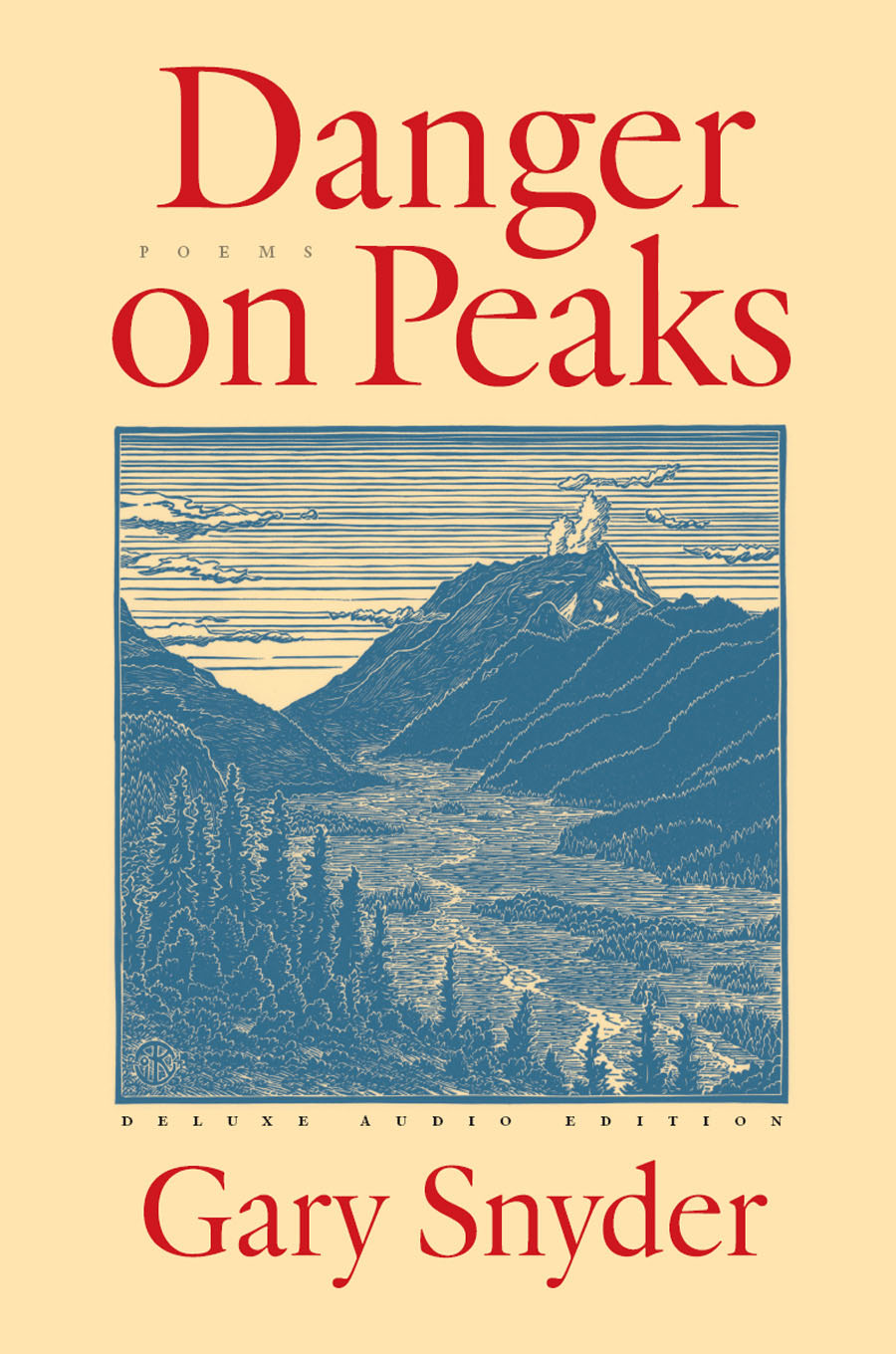Danger on Peaks
Authors: Gary Snyder


Â

Books by Gary Snyder
POETRY
Riprap and Cold Mountain Poems
Myths and Texts
The Back Country
Regarding Wave
Turtle Island
Axe Handles
Left Out in the Rain
No Nature
Mountains and Rivers Without End
PROSE
Earth House Hold
He Who Hunted Birds in His Father's Village
Passage Through India
The Real Work
The Practice of the Wild
A Place in Space
The Gary Snyder Reader
Back on the Fire
The High Sierra of California
(with Tom Killion)
Tamalpais Walking
(with Tom Killion)
The Selected Letters of Allen Ginsberg and Gary Snyder
Distant Neighbors: The Selected Letters of Wendell Berry and Gary Snyder

Copyright © 2004, 2014 by Gary Snyder
All rights reserved. No part of this book may be used or reproduced in any manner whatsoever without written permission from the Publisher, except in the case of brief quotations embodied in critical articles and reviews.
CDs recorded and produced by Jack Loeffler
ISBN 978-1-61902-451-9
Library of Congress Cataloging-in-Publication Data
Snyder, Gary, 1930â
Danger on Peaks : poems / Gary Snyder.
p. cm.
Includes bibliographical references.
ISBN 978-1-61902-405-2
I. Title.
PS3569.N88D36 2004
811'.54 â dc22Â Â Â 2004011649
Jacket and text design by David Bullen
Jacket art by Tom Killion
COUNTERPOINT
2560 Ninth Street, Suite 318
Berkeley, CA 94710
Printed by RR Donnelley in China
Distributed by Publishers Group West
10Â Â 9Â Â 8Â Â 7Â Â 6Â Â 5Â Â 4Â Â 3Â Â 2Â Â 1
F
OR
C
AROLE
“. . . danger on peaks.”
C
ONTENTS
- I
  Â
Mount St. Helens - II
  Â
Yet Older Matters - III
  Â
Daily Life - IV
  Â
Steady, They Say- Doctor Coyote When He Had a Problem
- Claws / Cause
- How Many?
- Loads on the Road
- Carwash Time
- To All the Girls Whose Ears I Pierced Back Then
- She Knew All About Art
- Coffee, Market, Blossoms
- In the Santa Clarita Valley
- Almost Okay Now
- Sus
- Day's Driving Done
- Snow Flies, Burn Brush, Shut Down
- Icy Mountains Constantly Walking
- For Philip Zenshin Whalen
- For Carole
- Steady, They Say
- Doctor Coyote When He Had a Problem
- V
  Â
Dust in the Wind - VI
  Â
After Bamiyan
Danger
on Peaks
I
Mount St. Helens
L
OOWIT
from Sahaptin / lawilayt-Lá / “Smoker, Smoky”
T
HE
M
OUNTAIN
From the doab of the Willamette and the Columbia, slightly higher ground, three snowpeaks can be seen when it's clear â Mt. Hood, Mt. Adams, and Mt. St. Helens. A fourth, Mt. Rainier, farther away, is only visible from certain spots. In a gentle landscape like the western slope, snowpeaks hold much power, with their late afternoon or early morning glow, light play all day, and always snow. The Columbia is a massive river with a steady flow. Those peaks and the great river, and the many little rivers, set the basic form of this green wooded Northwest landscape. Whether suburban, rural, or urban the rivers go through it and the mountains rise above.
Mt. St. Helens, “Loowit” (said to be the “Indian name”) â a perfect snowcapped volcanic cone, rising from almost sea level to (back then) 9,677 feet. I always wanted to go there. Hidden on the north side in a perched basin is a large deep lake.
Spirit Lake
When I first saw Spirit Lake I was thirteen. It was clear and still, faint wisps of fog on the smooth silvery surface, encircled by steep hills of old fir. The paved road ended at the outlet, right by the Spirit Lake Lodge. A ways down the dirt road was a little shingle Forest Service Ranger Station. Farther down was a camp.
Looking out on the lake and across, only forested hills. Cool silence. South of the ranger station a dirt road climbed steadily up to a lighter drier zone. It was three miles to timberline. The mountain above the lake: they reflected each other. Maybe the mountain in the lake survives.
The camp had tent platforms under the big trees in a web of soft fir-floor trails. They were all near the water. It was so dark on the forest floor that there was almost no undergrowth, just a few skinny huckleberries. The camp had a big solid wood and stone kitchen building, and a simple half-open dining hall. There was one two-story lodge in the rustic stone and log construction that flourished (making work for skilled carpenters) during the Depression.
From the camp by the lake we went out on several-day hikes. Loading Trapper Nelson packboards, rolling our kapok sleeping bags tight, and dividing the loads of groceries and blackened #10 can cook pots with wire bail handles. The trails took us around the lake and up to the ridges: Coldwater Mt. Lookout and on to Mt. Margaret and beyond, into a basin of lakes and snowfields nestled below. From the ridges we could look back to Spirit Lake and the mountain with its symmetry and snowfields. We walked through alpine flowers, kicked steps traversing snowfields, glissaded down and settled in by rocky lakes to boisterous campsites and smoky crusty tincan meals all cooked by boys.
T
HE
C
LIMB
Walking the nearby ridges and perching on the cliffs of Coldwater Mountain, I memorized the upper volcano. The big and little Lizards (lava ridges with their heads uphill), the Dogshead, with a broad bulge of brown rock and white snowpatches making it look faintly like a St. Bernard. The higher-up icefields with the schrund and wide crevasses, and the approach slopes from timberline. Who wouldn't take the chance to climb a snowpeak and get the long view?
Two years later the chance came. Our guide was an old-time Mazama from Tigard in Oregon. His climbing life went back to World War One. Then he got a big orchard. He wore a tall black felt hunting hat, high corked loggers-boots, stagged-off pants, and carried the old style alpenstock. We put white zinc oxide paste on our noses and foreheads, each got our own alpenstock, and we wore metal-rimmed dark goggles like Sherpas in the thirties. We set out climbing the slidey pumice lower slopes well before dawn.
Step by step, breath by breath â no rush, no pain. Onto the snow on Forsyth Glacier, over the rocks of the Dogshead, getting a lesson in alpenstock self-arrest, a talk on safety and patience, and then on to the next phase: ice. Threading around crevasses, climbing slow, we made our way to the summit just like Issa's
“Inch by inch
  little snail
  creep up Mt. Fuji”
ISSA
West Coast snowpeaks are too much! They are too far above the surrounding lands. There is a break between. They are in a different world. If you want to get a view of the world you live in, climb a little rocky mountain with a neat small peak. But the big snowpeaks pierce
the realm of clouds and cranes, rest in the zone of five-colored banners and writhing crackling dragons in veils of ragged mist and frost-crystals, into a pure transparency of blue.
St. Helens' summit is smooth and broad, a place to nod, to sit and write, to watch what's higher in the sky and do a little dance. Whatever the numbers say, snowpeaks are always far higher than the highest airplanes ever get. I made my petition to the shapely mountain, “Please help this life.” When I tried to look over and down to the world below â
there was nothing there
.
And then we grouped up to descend. The afternoon snow was perfect for glissade and leaning on our stocks we slid and skidded between cracks and thumps into soft snow, dodged lava slabs, got into the open snowfield slopes and almost flew to the soft pumice ridges below. Coming down is so fast! Still high we walked the three-mile dirt road back to the lake.
A
TOMIC
D
AWN
The day I first climbed Mt. St. Helens was August 13, 1945.
Spirit Lake was far from the cities of the valley and news came slow. Though the first atomic bomb was dropped on Hiroshima August 6 and the second dropped on Nagasaki August 9, photographs didn't appear in the
Portland Oregonian
until August 12. Those papers must have been driven in to Spirit Lake on the 13th. Early the morning of the 14th I walked over to the lodge to check the bulletin board. There were whole pages of the paper pinned up: photos of a blasted city from the air, the estimate of 150,000 dead in Hiroshima alone, the American scientist quoted saying “nothing will grow there again for seventy years.” The morning sun on my shoulders, the fir forest smell and the big tree shadows; feet in thin moccasins feeling the ground, and my heart still one with the snowpeak mountain at my back. Horrified, blaming scientists and politicians and the governments of the world, I swore a vow to myself, something like, “By the purity and beauty and permanence of Mt. St. Helens, I will fight against this cruel destructive power and those who would seek to use it, for all my life.”
